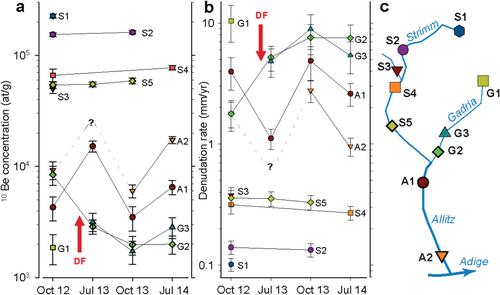当前位置:
X-MOL 学术
›
Earth Surf.Process. Land.
›
论文详情
Our official English website, www.x-mol.net, welcomes your
feedback! (Note: you will need to create a separate account there.)
Evaluating debris‐flow and anthropogenic disturbance on 10Be concentration in mountain drainage basins: implications for functional connectivity and denudation rates across time scales
Earth Surface Processes and Landforms ( IF 2.8 ) Pub Date : 2020-10-06 , DOI: 10.1002/esp.5012 Francesco Brardinoni 1 , Reto Grischott 2 , Florian Kober 2 , Corrado Morelli 3 , Marcus Christl 4
Earth Surface Processes and Landforms ( IF 2.8 ) Pub Date : 2020-10-06 , DOI: 10.1002/esp.5012 Francesco Brardinoni 1 , Reto Grischott 2 , Florian Kober 2 , Corrado Morelli 3 , Marcus Christl 4
Affiliation

|
We examine the sensitivity of 10Be concentrations (and derived denudation rates), to debris‐flow and anthropogenic perturbations in steep settings of the Eastern Alps, and explore possible relations with structural geomorphic connectivity. Using cosmogenic 10Be as a tracer for functional geomorphic connectivity, we conduct sampling replications across four seasons in Gadria, Strimm and Allitz Creek. Sampling sites encompass a range of structural connectivity configurations, including the conditioning of a sackung, all assessed through a geomorphometric index (IC). By combining information on contemporary depth of erosion and sediment yield, disturbance history and post‐LGM (Last Glacial Maximum) sedimentation rates, we constrain the effects of debris‐flow disturbance on 10Be concentrations at the Gadria sites. Here, we argue that bedrock weakening imparted by the sackung promotes high depth of erosion. Consequently, debris flows recruit sediment beyond the critical depth of spallogenic production (e.g., >3 m), which in turn, episodically, due to predominantly muogenic production pathways, lowers 10Be concentration by a factor of 4, for at least 2 years. In contrast, steady erosion in Strimm Creek yields very stable 10Be concentrations through time. In Allitz Creek, we observe two‐ to fourfold seasonal fluctuations in 10Be concentrations, which we explain as the combined effects of water diversion and hydraulic structures on sediment mixing. We further show that 10Be concentration correlates inversely with the IC index, where sub‐basins characterized by high concentrations (long residence times) exhibit low IC values (structurally disconnected) and vice versa, implying that, over millennial time scales a direct relation exists between functional and structural connectivity, and that the IC index performed as a suitable metric for structural connectivity. The index performs comparably better than other metrics (i.e., mean slope and mean normalized channel steepness index) previously used to assess topographic controls on denudation rates in active unglaciated ranges. In terms of landscape evolution, we argue that the sackung, by favouring intense debris‐flow activity across the Holocene, has aided rapid postglacial reshaping of the Gadria basin, which currently exhibits a topographic signature characteristic of unglaciated debris‐flow systems. © 2020 John Wiley & Sons, Ltd.
中文翻译:

评估山区流域10Be浓度的泥石流和人为干扰:跨时间尺度对功能连通性和剥蚀率的影响
我们研究了10 Be浓度(及其导出的剥蚀率)对东部阿尔卑斯山陡峭地区的泥石流和人为扰动的敏感性,并探讨了与构造地貌连通性的可能关系。使用宇宙成因10 Be作为功能性地貌连通性的示踪剂,我们在加德里亚(Gadria),斯特里姆(Strimm)和阿里茨河(Allitz Creek)的四个季节中进行采样复制。采样地点包括一系列结构连通性配置,包括袋装条件,所有这些都通过地貌指数(IC)进行评估。通过结合有关当代侵蚀深度和沉积物产量,扰动历史以及LGM(最后冰川期)沉积速率的信息,我们限制了泥石流扰动对10 Ga集中在Gadria站点。在这里,我们认为,由袋囊赋予的基岩弱化促进了高深度的侵蚀。因此,泥石流将沉积物带入散裂产生的临界深度(例如,> 3 m)之外,这主要是由于诱变产生的途径,进而在至少2年的时间内使10 Be的浓度降低了4倍。相反,Strimm Creek的稳定侵蚀会随着时间的推移产生非常稳定的10 Be浓度。在阿里茨河,我们观察到10 Be浓度的2至4倍的季节性波动,我们将其解释为引水和水力结构对沉积物混合的综合影响。我们进一步证明10浓度与IC指数成反比,其中以高浓度(长停留时间)为特征的子盆地表现出较低的IC值(结构上断开),反之亦然,这意味着在千年时间尺度上,功能和结构连通性之间存在直接关系,并且IC索引作为结构连接的合适指标。该指数的性能比以前用于评估活跃非冰冻范围内的剥蚀率的地形控制的其他指标(即平均斜率和平均归一化渠道陡度指数)要好。在景观演变方面,我们认为,沙袋洞通过促进全新世强烈的泥石流活动,有助于加德里亚盆地的快速冰期改造后,目前显示出无冰川泥石流系统的地形特征。分级为4 +©2020 John Wiley&Sons,Ltd.
更新日期:2020-12-14
中文翻译:

评估山区流域10Be浓度的泥石流和人为干扰:跨时间尺度对功能连通性和剥蚀率的影响
我们研究了10 Be浓度(及其导出的剥蚀率)对东部阿尔卑斯山陡峭地区的泥石流和人为扰动的敏感性,并探讨了与构造地貌连通性的可能关系。使用宇宙成因10 Be作为功能性地貌连通性的示踪剂,我们在加德里亚(Gadria),斯特里姆(Strimm)和阿里茨河(Allitz Creek)的四个季节中进行采样复制。采样地点包括一系列结构连通性配置,包括袋装条件,所有这些都通过地貌指数(IC)进行评估。通过结合有关当代侵蚀深度和沉积物产量,扰动历史以及LGM(最后冰川期)沉积速率的信息,我们限制了泥石流扰动对10 Ga集中在Gadria站点。在这里,我们认为,由袋囊赋予的基岩弱化促进了高深度的侵蚀。因此,泥石流将沉积物带入散裂产生的临界深度(例如,> 3 m)之外,这主要是由于诱变产生的途径,进而在至少2年的时间内使10 Be的浓度降低了4倍。相反,Strimm Creek的稳定侵蚀会随着时间的推移产生非常稳定的10 Be浓度。在阿里茨河,我们观察到10 Be浓度的2至4倍的季节性波动,我们将其解释为引水和水力结构对沉积物混合的综合影响。我们进一步证明10浓度与IC指数成反比,其中以高浓度(长停留时间)为特征的子盆地表现出较低的IC值(结构上断开),反之亦然,这意味着在千年时间尺度上,功能和结构连通性之间存在直接关系,并且IC索引作为结构连接的合适指标。该指数的性能比以前用于评估活跃非冰冻范围内的剥蚀率的地形控制的其他指标(即平均斜率和平均归一化渠道陡度指数)要好。在景观演变方面,我们认为,沙袋洞通过促进全新世强烈的泥石流活动,有助于加德里亚盆地的快速冰期改造后,目前显示出无冰川泥石流系统的地形特征。分级为4 +©2020 John Wiley&Sons,Ltd.











































 京公网安备 11010802027423号
京公网安备 11010802027423号